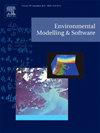Derivation of characteristic physioclimatic regions through density-based spatial clustering of high-dimensional data
IF 4.8
2区 环境科学与生态学
Q1 COMPUTER SCIENCE, INTERDISCIPLINARY APPLICATIONS
引用次数: 0
Abstract
Physioclimatic regions are homogeneous geospatial entities that exhibit similar characteristics in both climatic conditions and the physiographic environment. They provide a foundation for a broad range of analyses in earth system sciences that are conditional on the prevailing climatological properties shaping geographical areas. However, delineating such regions is challenging due to high-dimensional input data and nonlinear processes in nature. We introduce a nonparametric clustering methodology to derive geospatial clusters with similar physioclimatic attributes, using a comprehensive dataset of climatological and geomorphometric indices from Austria. Our analysis workflow includes (1) Principal Component Analysis (PCA) for linear dimension reduction, (2) Uniform Manifold Approximation and Projection (UMAP) for nonlinear dimension reduction, (3) Hierarchical Density-Based Spatial Clustering of Applications with Noise (HDBSCAN) for clustering and (4) random forest for feature importance assessment. Results show both agreement and differences compared to reference classification, thereby highlighting the need for quantitative performance evaluation and synoptic plausibility assessment. Findings include the identification of two characteristic clusters for inneralpine valleys in Western Austria and interfluves in the Styrian basin. This workflow offers a blueprint for delineating consistent geospatial regions for various applications. Clusters obtained with this approach may assist in unearthing new perspectives on regionalisation, provide new insights in the underlying characteristics determining these regions, and thus aid in the understanding of complex environmental patterns.
求助全文
约1分钟内获得全文
求助全文
来源期刊

Environmental Modelling & Software
工程技术-工程:环境
CiteScore
9.30
自引率
8.20%
发文量
241
审稿时长
60 days
期刊介绍:
Environmental Modelling & Software publishes contributions, in the form of research articles, reviews and short communications, on recent advances in environmental modelling and/or software. The aim is to improve our capacity to represent, understand, predict or manage the behaviour of environmental systems at all practical scales, and to communicate those improvements to a wide scientific and professional audience.
 求助内容:
求助内容: 应助结果提醒方式:
应助结果提醒方式:


